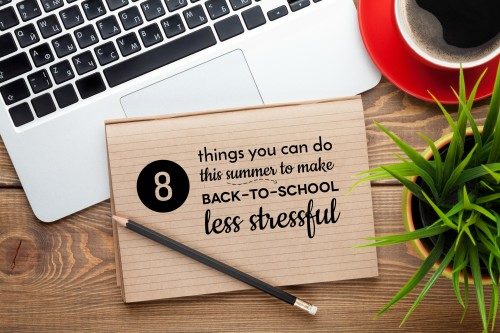Some teachers have no problem disconnecting from work over the summer and truly giving themselves a break. (Enjoy! Your time off is incredibly short, and you’ve earned it.)
But other teachers struggle to turn off their “teacher brains” and feel like the countdown clock for back-to-school is always ticking in their minds. It can be tough to relax when you know you have 70+ hour weeks ahead of you in the fall.
Here’s my advice to those of you who WANT to use part of your summer to get ahead for fall: focus on tasks that will create more time for you later.
Generally, early back-to-school prep consists of daydreaming about cool ideas and decorating options. This can be fun and creative work, but if it’s the only thing you do this summer, you’ll probably find that your workload is still very heavy once school starts.
If you’re going to think about school this summer, think about ways you can set yourself up for success later. These 8 tasks will help you feel more prepared for the start of the year so you can relax more this summer…and they’ll help you truly get ahead so you work less in the fall.

1. Identify the 3 biggest stressors you had last school year, and plan ways to streamline or simplify.
Did you spend too much time grading papers? Were you totally lost when figuring out how to differentiate instruction? Did you get bogged down in data collection and paperwork? Start brainstorming solutions so this year will be different! You can talk with other teachers (including those online), look for suggestions in teacher blogs or Pinterest, or read a book on the topic.
Be pro-active and take charge of your professional development! If some aspect of your work has been stressing you out, look for a better way. I promise you it’s out there!
2. Sketch out your new classroom arrangement.
Map everything out on paper (or with a digital tool like this one or this one) so you can move your furniture and set things up quickly on your first day back. Do the deep thinking now about where to store supplies so students can access them easily, and how you can organize your room to facilitate productivity and routines. Then when school starts, all you have to do is execute the plan!
3. Outline all of your routines and procedures (and when/how you’ll teach them.)
Writing everything down will solidify the procedures in your mind and provide a reference if needed for you (or a substitute.) If there were specific procedures your students needed reminders with all year long or that just drove you crazy, plan out a better way…including how to teach your expectations to students and model, practice, and reinforce them.
4. Write lessons plans for EVERYTHING you’ll teach during the first week of school.
You probably won’t follow them exactly or get to everything you’ve planned, but you should know which procedures you’ll want to teach, when you’ll teach them, and how you’ll teach them. Choose your get-to-know-you and community-building resources now so all you have left to do is decide which day to use them on. Having a precise written breakdown of what you’re teaching and when will help prevent those first-day-of-school nightmares that so many of us grapple with!
5. Organize your digital files and teaching resources.
Sometimes lesson planning is overwhelming because we have too many resources that we don’t really like. It’s kind of like opening your overstuffed bedroom closet and realizing you wear the same 10 outfits over and over again! Getting rid of things you don’t like will make it much easier to find the stuff you do like when it’s time to plan. So, use your summer to toss out or pass on any materials that you don’t absolutely love using with your students.
If you don’t yet utilize Dropbox to organize digital files, try setting up Dropbox folders for each unit you teach. Even if you don’t have the time and energy to organize your existing digital files this summer, you can at least use the Dropbox folders to add new resources as you add them, and you can add the older stuff to the appropriate folder when it comes time to teach each unit.
6. Map out a pacing guide for the year.
If your school provides one, go through and add specific activities you plan to use each week. If your school doesn’t provide one, make your own curriculum map so you know what you’ll be teaching each month. This will help you see the big picture of what you want students to learn and make it easier to toss out the activities that you clearly won’t have time for.
7. List the skills/standards you need more activities for, search them out online, then plug them into your pacing guide.
Start with the topics you dread teaching because you personally dislike them or because you have a hard time making them understandable and meaningful for kids. Look for teaching ideas that will improve these units now and save them in Evernote, a Pinterest board, or a Dropbox folder. Then, all you have to do during the school year is plug them into your lesson plans. It’s much more efficient to batch similar tasks, so go ahead and dedicate an entire afternoon to perusing Pinterest for all kinds of awesome materials now, rather than going on there every single weekend to find resources for just your current unit of study.
Write an outline of the main activities for each unit you teach. (For example, on day 1 of your geometry unit, you’ll show X video and do a brainstorming activity; on Day 2, you’ll do a hands-on investigation.) You can either create your unit activities outline within your pacing guide or in a list that you store with the materials for that unit. This will make lesson planning faster when you’re ready to teach the unit, and will also help you pace yourself appropriately to make sure you have time for the activities that have the biggest impact on student learning.
8. Watch the free video series to learn how you can make time for everything that matters to you this summer.
I created a 7 part video series to help you make this summer (and fall) your best one yet. If you want more tips and advice like you’ve read in this blog post, check out this 60 minute training!
I’m going to share how you can:
- Create your end-of-summer vision (what do you want your life to look like when summer is over?) and select goals that will move you toward that vision
- Use simple time-saving tips that will help you work smarter, not harder, right away
- Implement 5 productivity strategies for home and school that will help you feel more accomplished AND allow you to truly relax
- Design a strategy for using your summer to get ahead for fall, choosing key tasks to complete now in order to free up more time once school begins
Once you’ve watched the training, I’ll send you my summer planning guide to help you get your game plan together. It’s designed to help you implement the ideas you learned through the video series. If you’re not yet clear on your end-of-summer vision and what kind of things you should do this summer to make that vision a reality…no worries, this guide gives you a step-by-step system for figuring it out.
Watch the free video series now!

Angela Watson
Founder and Writer
Sign up to get new Truth for Teachers articles in your inbox
Discussion
OR

Join our
community
of educators
If you are a teacher who is interested in contributing to the Truth for Teachers website, please click here for more information.

















I have a question about the free video. If I don’t watch the entire thing continuous, Pinterest makes me go back and renter my email to watch the next one. Any suggestions on how to the the video without having to go through Pinterest?
Yep–when you sign up, an email is sent to you. Just click the link in the email and you can finish watching anytime!
These are all fantastic tips! My main summer project will be #5. I feel like I have a lot of ‘digital clutter’ because I save, bookmark, and screenshot a LOT during the school year. I can’t wait to spend some time this summer sorting through everything I’ve digitally saved on my computer, phone, and iPad and then sort, file, or delete as needed to get a fresh, organized start to the next school year!